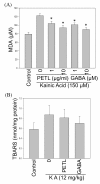Pu-Erh tea and GABA attenuates oxidative stress in kainic acid-induced status epilepticus
- PMID: 22014163
- PMCID: PMC3217899
- DOI: 10.1186/1423-0127-18-75
Pu-Erh tea and GABA attenuates oxidative stress in kainic acid-induced status epilepticus
Abstract
Background: Pu-Erh tea is one of the most-consumed beverages due to its taste and the anti-anxiety-producing effect of the gamma-aminobutyric acid (GABA) if contains. However the protective effects of Pu-Erh tea and its constituent, GABA to kainic acid (KA)-induced seizure have not been fully investigated.
Methods: We analyzed the effect of Pu-Erh tea leaf (PETL) and GABA on KA-induced neuronal injury in vivo and in vitro.
Results: PETL and GABA reduced the maximal seizure classes, predominant behavioral seizure patterns, and lipid peroxidation in male FVB mice with status epilepticus. PETL extracts and GABA were effective in protecting KA-treated PC12 cells in a dose-dependent manner and they decreased Ca(2+) release, ROS production and lipid peroxidation from KA-stressed PC12 cells. Western blot results revealed that mitogen-activated protein kinases (MAPKs), RhoA and cyclo-oxygenase-2 (COX-2) expression were increased in PC12 cells under KA stress, and PETL and GABA significantly reduced COX-2 and p38 MAPK expression, but not that of RhoA. Furthermore, PETL and GABA reduced PGE(2) production from KA-induced PC12 cells.
Conclusions: Taken together, PETL and GABA have neuroprotective effects against excitotoxins that may have clinical applications in epilepsy.
Figures









Similar articles
-
Fresh green tea and gallic acid ameliorate oxidative stress in kainic acid-induced status epilepticus.J Agric Food Chem. 2012 Mar 7;60(9):2328-36. doi: 10.1021/jf203709q. Epub 2012 Feb 24. J Agric Food Chem. 2012. PMID: 22324774
-
Sesamin ameliorates oxidative stress and mortality in kainic acid-induced status epilepticus by inhibition of MAPK and COX-2 activation.J Neuroinflammation. 2011 May 24;8:57. doi: 10.1186/1742-2094-8-57. J Neuroinflammation. 2011. PMID: 21609430 Free PMC article.
-
Neuroprotective effects of carnosic acid on neuronal cells under ischemic and hypoxic stress.Nutr Neurosci. 2012 Nov;15(6):257-63. doi: 10.1179/1476830512Y.0000000021. Nutr Neurosci. 2012. PMID: 22687582
-
Dose-Dependent Behavioral and Antioxidant Effects of Quercetin and Methanolic and Acetonic Extracts from Heterotheca inuloides on Several Rat Tissues following Kainic Acid-Induced Status Epilepticus.Oxid Med Cell Longev. 2019 Dec 19;2019:5287507. doi: 10.1155/2019/5287507. eCollection 2019. Oxid Med Cell Longev. 2019. PMID: 31949879 Free PMC article.
-
GABA-enriched teas as neuro-nutraceuticals.Neurochem Int. 2020 Dec;141:104895. doi: 10.1016/j.neuint.2020.104895. Epub 2020 Nov 2. Neurochem Int. 2020. PMID: 33144101 Review.
Cited by
-
Neuroprotective and Anti-Amyloid β Effect and Main Chemical Profiles of White Tea: Comparison Against Green, Oolong and Black Tea.Molecules. 2019 May 19;24(10):1926. doi: 10.3390/molecules24101926. Molecules. 2019. PMID: 31109117 Free PMC article.
-
Gamma Amino Butyric Acid Attenuates Brain Oxidative Damage Associated with Insulin Alteration in Streptozotocin-Treated Rats.Indian J Clin Biochem. 2017 Jun;32(2):207-213. doi: 10.1007/s12291-016-0597-2. Epub 2016 Jul 30. Indian J Clin Biochem. 2017. PMID: 28428696 Free PMC article.
-
Quality and freshness of human bone marrow-derived mesenchymal stem cells decrease over time after trypsinization and storage in phosphate-buffered saline.Sci Rep. 2017 Apr 24;7(1):1106. doi: 10.1038/s41598-017-01315-0. Sci Rep. 2017. PMID: 28439086 Free PMC article.
-
γ-Aminobutyric Acid Effectively Modulate Growth Performance, Physiological Response of Largemouth Bass (Micropterus Salmoides) Under Combined Stress of Flow Velocity and Density.Aquac Nutr. 2024 Oct 24;2024:9180554. doi: 10.1155/2024/9180554. eCollection 2024. Aquac Nutr. 2024. PMID: 39555528 Free PMC article.
-
Pu-erh Tea Protects the Nervous System by Inhibiting the Expression of Metabotropic Glutamate Receptor 5.Mol Neurobiol. 2017 Sep;54(7):5286-5299. doi: 10.1007/s12035-016-0064-3. Epub 2016 Aug 30. Mol Neurobiol. 2017. PMID: 27578019 Free PMC article.
References
-
- Chiang CT, Weng MS, Lin-Shiau SY, Kuo KL, Tsai YJ, Lin JK. Pu-erh tea supplementation suppresses fatty acid synthase expression in the rat liver through downregulating Akt and JNK signalings as demonstrated in human hepatoma HepG2 cells. Oncol Res. 2005;16:119–128. - PubMed
MeSH terms
Substances
LinkOut - more resources
Full Text Sources
Research Materials
Miscellaneous

